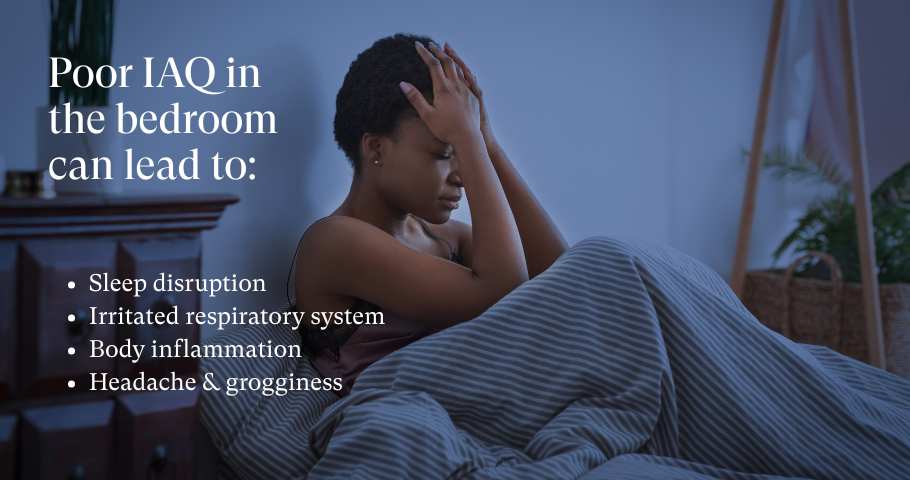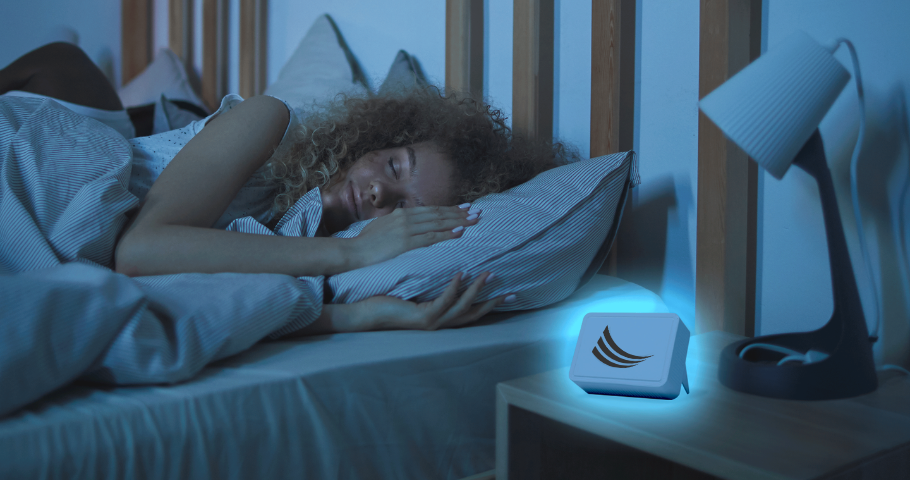How Poor Indoor Air Quality Affects Sleep — and 5 Tips You Can Do to Improve It
For many of us, getting better rest is a top health goal — and it usually involves tips like cutting screen time, using blackout curtains, or investing in a new mattress. But one of the most overlooked factors influencing sleep quality is something we can’t always see or smell: air quality – and poor indoor air quality affects sleep more than you know.
Your bedroom’s indoor air quality may be quietly sabotaging your ability to fall asleep, stay asleep, and feel refreshed the next day. From particulate matter like PM2.5 to chemical pollutants like VOCs, polluted air can interfere with your body’s natural rhythms, irritate your respiratory system, and even affect your brain and nervous system.
In this blog, we’ll break down how air quality impacts your sleep quality, what the science says about pollutants and sleep disruption, and what practical steps you can take — including using the right air purifier — to transform your sleep environment into a cleaner, healthier space.
Why Indoor Air Quality is So Important for Sleep
While it’s easy to think of pollution as an outdoor issue, the According to the Environmental Protection Agency (EPA) indoor air quality is often 2 to 5 times worse than outside. This matters even more at night, when you’re spending 7–9 hours in one enclosed space — your bedroom — with limited ventilation.
Polluted indoor air can directly lead to sleep disruption, irritate your lungs, and cause inflammation throughout your body. Furthermore, your body becomes more vulnerable to environmental stressors while you sleep, including airborne pollutants.

How Pollution in Indoor Air Quality Affects Sleep Quality
Now that we know poor indoor air quality affects sleep, let’s look at the main types of indoor air pollutants that are known to affect sleep quality, and why they do so:
1. Particulate Matter (PM2.5)
Particulate matter refers to tiny airborne particles that are 2.5 microns or smaller — small enough to be inhaled deeply into the lungs and even enter the bloodstream. Sources include cooking fumes, smoke, dust, and outdoor air that gets inside.
When inhaled during sleep, PM2.5 can cause micro-inflammation in the respiratory tract and brain, interfering with the nervous system and disrupting your body’s natural repair mechanisms.
2. Volatile Organic Compounds (VOCs)
VOCs are emitted from paints, cleaning products, candles, air fresheners, furniture, and even laundry detergents. These chemicals can cause headaches, congestion, and nausea — all of which can reduce sleep quality and disrupt your rest.
3. High CO2
While not a direct pollutant, high levels caused by poor ventilation can disrupt sleep. Symptoms and reasons include:
- Headaches: Elevated CO2 levels can lead to dull, persistent headaches.
- Fatigue: Poor ventilation may result in tiredness and lethargy due to reduced oxygen availability.
- Difficulty Concentrating: High CO2 can impair cognitive function, making it hard to focus.
- Restless Sleep: Disruptions in sleep patterns, leading to frequent waking at night.
- Drowsiness: Increased CO2 levels may cause feelings of drowsiness during the day.
Addressing these indoor air quality issues is crucial for maintaining a healthy living environment. Proper ventilation, regular cleaning, and using air purifiers can help mitigate these effects.
New Research on Air Quality and Sleep Disruption
A 2020 field review of indoor air quality during sleep evaluated common nighttime environments and found:
- 86% of bedrooms exceeded the WHO threshold for PM2.5 levels
- VOCs were commonly above safe limits
- Poor air quality often coincided with markers of poor sleep quality – a clear sign that indoor air quality affects sleep
This means that even homes that appear “clean” can expose occupants to unhealthy particulate matter and gases that affect breathing and rest.
The Role of Your Nervous System in Sleep and Air Exposure
Your body’s nervous system plays a key role in transitioning from wakefulness to sleep. During the night, the parasympathetic nervous system is supposed to take over, slowing your heart rate and calming your brain. However, when you’re exposed to air pollution — especially fine particulate matter and VOCs — it can trigger stress responses, elevate cortisol levels, and keep your body in a low-level state of alert.
This environmental stress leads to:
- Shorter REM cycles
- More frequent awakenings
- Hormonal imbalances
- Less efficient recovery
Poor Air Quality and Your Circadian Rhythm
Your circadian rhythm is your internal 24-hour clock that governs when you feel sleepy and when you feel alert. If air quality is poor and indoor air quality affects sleep for you on a regular basis, it can throw off this rhythm by activating inflammation and reducing melatonin production — the hormone that signals bedtime.
Some pollutants can even affect gene expression related to the circadian rhythm, meaning long-term exposure could permanently alter your body’s sleep timing.
Common Sources of Poor Indoor Air Quality
To truly improve sleep quality, it’s important to understand what might be degrading the air quality in your bedroom. Here are a few typical culprits:
- Gas stoves and space heaters (which can release particulate matter and even carbon monoxide)
- Scented candles, incense, and essential oils (sources of VOCs)
- Carpets and rugs that collect dust and allergens
- Furniture made with synthetic materials or adhesives
- Lack of ventilation or old HVAC filters
Even pets and people can introduce new pollutants into your bedroom environment!

How to Improve Air Quality in Your Bedroom
Now that you know what’s at stake in how your indoor air quality affects sleep, here’s how to clean up your bedroom’s air quality and improve your sleep quality naturally.
1. Invest in a High-Quality Air Purifier
When it comes to improving your sleep quality, reducing indoor pollutants like particulate matter, VOCs, and allergens is key. While many air purifiers rely solely on activated carbon to capture odors and gases, EnviroKlenz’s patented earth mineral technology goes a step further by neutralizing harmful airborne chemicals rather than just trapping them. Combined with hospital-grade HEPA filtration, it provides a more comprehensive approach to tackling the contaminants that contribute to sleep disruption.
2. Open Windows (When It’s Safe)
Weather and location permitting, opening windows in the early morning can help flush out stale air and reduce indoor pollutant buildup — especially CO₂ and VOCs.
3. Switch to Low-VOC Products
Use low- or zero-VOC paint, cleaning products, and laundry detergents. Avoid synthetic air fresheners and candles, and look for natural alternatives labeled “non-toxic.”
4. Clean and Dust Regularly
Dust is a major source of particulate matter indoors. Use a HEPA-filter vacuum and microfiber cloths to reduce airborne particles.
5. Replace HVAC and Air Filters
Dirty HVAC filters recirculate pollutants through your home. Make sure to replace filters every 1–3 months, or use a SMART filter system that alerts you when it’s time.
Monitor Your Indoor Air Quality for Better Sleep

One of the most effective ways to gain control over your environment is to use a smart indoor air quality sensor. These tools measure levels of PM2.5, VOCs, humidity, and CO₂ — giving you real-time insights into what’s impacting your sleep quality.
Look for monitors that integrate with your air purifier or HVAC system so you can automate adjustments for cleaner air.
Long-Term Benefits of Cleaner Air
Improving air quality in your home isn’t just good for sleep — it’s good for your whole body. Long-term benefits include:
- Stronger immune function
- Better lung and heart health
- Improved cognitive clarity
- Lower risk of mood disorders
- And, of course, higher sleep quality
Take Control of Your Air and Sleep Better
Your bedroom should be the healthiest room in your house — a space for restoration, not risk. So, don’t let it turn into a place where indoor air quality affects sleep for you and others in your household. By taking control of your home’s air quality, you can dramatically reduce sleep disruption, protect your nervous system, and get back in sync with your natural circadian rhythm.
Whether it’s upgrading your air purifier, eliminating VOC sources, or tracking air pollutants with smart sensors, small changes can lead to huge improvements in your nightly rest.
